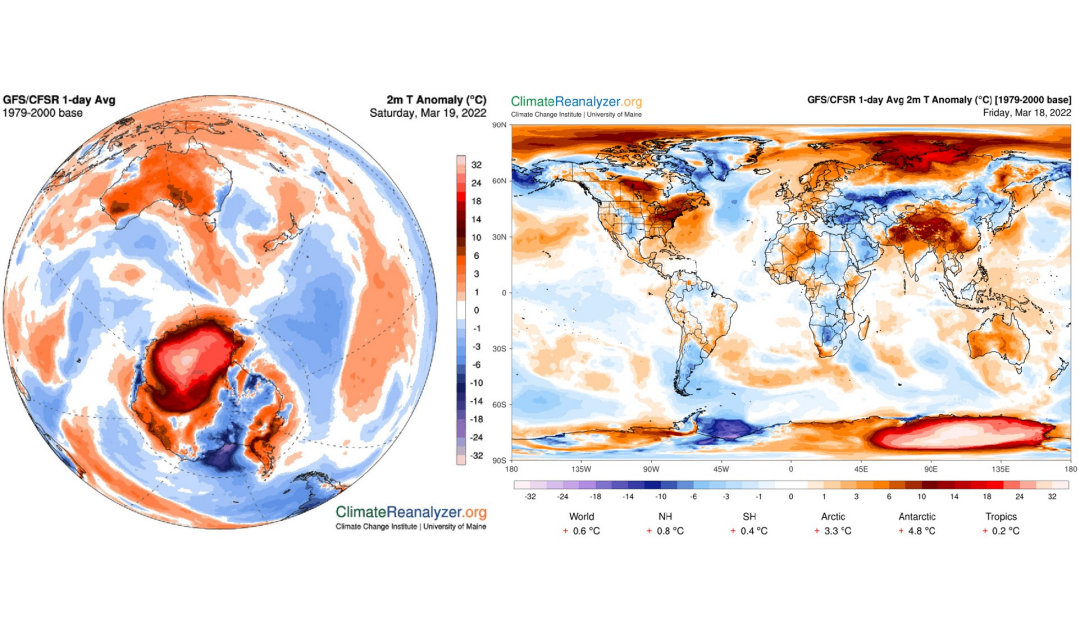
The Earth’s polar regions have been under pressure from ever-increasing warming for years. Yet not all regions are equally affected, and researchers are still investigating the reasons for the differences, especially between the Arctic and Antarctic. But in mid-March, measuring stations at both ends of the world delivered temperature data that left even the most hard-nosed experts speechless.
Measured temperature data at various stations in Antarctica on March 18 indicated up to a double-digit difference from the average temperature at this time of year. The Italian-French station Concordia, located 3,200 meters above sea level in the middle of Dome C, on the East Antarctic Ice Sheet, recorded a temperature of -11.5°C — nearly 40°C above the normal temperature of -50°C. At the Russian station Vostok, site of the lowest temperature ever recorded on Earth, a temperature of -17.7°C was measured , instead of the normal temperature of -32°C. And the Terra Nova station on the coast of the Ross Sea reported 7°C. Temperature data from the Arctic also astonished experts: at the North Pole, temperatures in mid-March were just at the freezing point, instead of the usual -30°C; on Svalbard warmer-than-normal temperatures caused heavy rains to pour down on Longyeabyen and Ny Ålesund, and on the more easterly islands temperatures were above freezing.

For the experts, on the one hand, the warm air bursts that had caused the high temperatures at the polar regions were not surprising. “Looking back over the last few decades, we can clearly see a warming trend, especially in the ‘cold season’ in the Arctic,” Ruth Mottram, a climate scientist at the Danish Meteorological Institute, wrote in an email to The Washington Post. But the intensity with which temperatures skyrocketed stunned many scientists.
“It’s impossible, we would have said two days ago. But as of today (March 18), Antarctic climatology will have to be rewritten,” tweeted Stefano Di Battista, a journalist and meteorologist, about Antarctic temperatures. Here, the reason was a flow of warm, moisture-saturated air from the north toward East Antarctica. Like a river in the atmosphere, vast amounts of moisture were thus transported into the otherwise dry-cold East Antarctic. Coastal stations such as Australian-run Casey and France’s Dumont d’Urville recorded heavy rainfall and melting. A subsequent high-pressure area pushed the air masses further south toward the pole and kept the warm, humid air there, which, like a shield, threw back the radiation from the continent and caused the high temperatures. These persisted for days after the air masses had finally departed.
Experts believe that this event was an extreme and not immediately the rule, at least in Antarctica. But they warn that a changing climate may cause these types of extreme events to occur more often. In the Arctic, such events have already been recorded more frequently in recent decades. In Antarctica, on the other hand, the trend has been in both directions. Because last winter, the lowest average temperature ever at the South Pole — -61°C — was recorded. Yet, already in summer, sea ice melted to a record minimum in some of the waters around Antarctica. Therefore, researchers want collect more data to make climate models even better. To this end, it is also hoped that insights from the past will be available in the form of ice cores from the ice sheets of East Antarctica and Greenland, plus better networking of meteorological observations and measurement data from Earth and space. Time is of the essence, as numerous research findings and the latest IPCC report show. Expert teams writing in that report conclude that the Earth is closer than previously thought to the tipping points at which it is no longer possible to reverse the warming or change a system.
Dr Michael Wenger, PolarJournal
More about this topic





